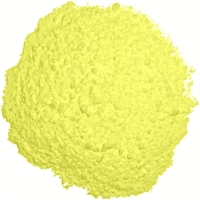Cyclooctasulfur
|
|
|||
 |
|||
 |
|||
| Names | |||
|---|---|---|---|
|
Systematic IUPAC name
Octathiocane
|
|||
| Identifiers | |||
|
3D model (Jmol)
|
|||
| ChEBI | |||
| ChemSpider | |||
| 2973 | |||
| MeSH | Cyclooctasulfur | ||
|
PubChem CID
|
|||
|
|||
|
|||
| Properties | |||
| S8 | |||
| Molar mass | 256.48 g·mol−1 | ||
| Appearance | Vivid, yellow, translucent crystals | ||
| Density | 2.07 g cm−3 | ||
| Melting point | 119 °C; 246 °F; 392 K | ||
| Boiling point | 159 °C; 318 °F; 432 K (decomposes) | ||
| log P | 6.117 | ||
| Thermochemistry | |||
|
Std molar
entropy (S |
32 J·mol−1·K−1 | ||
|
Std enthalpy of
formation (ΔfH |
0 kJ·mol−1 | ||
| Related compounds | |||
|
Related compounds
|
Hexathiane | ||
|
Except where otherwise noted, data are given for materials in their standard state (at 25 °C [77 °F], 100 kPa).
|
|||
| Infobox references | |||
Octasulfur is an inorganic chemical with the chemical formula S
8. It is a yellow solid, and is odourless and tasteless. It is the most common allotrope of sulfur. It is a major industrial chemical that occurs widely in nature.
The name octasulfur is the most commonly used; the preferred IUPAC name is cyclo-octasulfur. The compound is systematically named octathiocane, and cyclo-octasulfur. It is also the final member of the thiocane heterocylic series, where every carbon is substituted with a sulfur atom.
The compound adopts a crown conformation with D4dpoint group symmetry. The S–S bond lengths are equal, at about 2.05 Å. Octasulfur crystallizes in three distinct polymorphs: rhombohedral, and two monoclinic forms, of which only two are stable at standard conditions. The rhombohedral crystal form is the accepted standard. The remaining polymorph is only stable between 96 and 115 °C at 100 kPa. Octasulfur forms several allotropes: α-Sulfur, β-sulfur, γ-sulfur, λ-sulfur.
λ-Sulfur is the liquid form of octasulfur, from which γ-sulfur can be crystallised by quenching. If λ-sulfur is crystallised slowly, it will revert to β-sulfur. Since it must have been heated over 115 °C, neither crystallised β-sulfur or γ-sulfur will be pure. The only known method of obtaining pure γ-sulfur is by crystallising from solution.
Octasulfur easily forms large crystals, which are typically yellow and are somewhat translucent.
It is typically not produced as S8 per se. It is the main (99%) component of elemental sulfur, which is recovered from volcanic sources and is a major product of the Claus Process, associated with petroleum refineries.
...
Wikipedia


